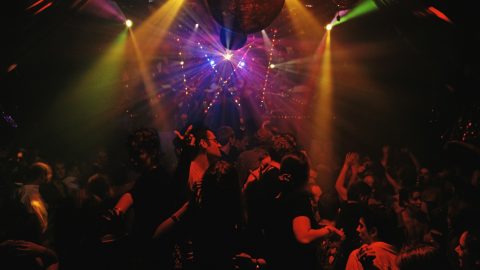
We should have been packed by now. In another, better timeline, we’d have spent yesterday trying to remember where we left our wellies. Today we’d be crammed into cars, sleeping bags under our feet to make space for more booze in the boot, setting off on the slow pilgrimage to some corner of a Pilton field that is forever Glastonbury.
Not this year; not in our new prevailing reality. Social distancing does not easily lend itself to 200,000 people getting mashed in the mud. We must make do. The BBC will be broadcasting classic sets all weekend, as close as you’ll get to the Pyramid stage in 2020, but what of the festival’s notorious late-night south-east corner? Surely you can’t recreate that decadent playground for the senses during life under lockdown?
The team behind Shangri-La, Glasto’s hedonistic festival-within-a-festival, believe they can, proving that you should never underestimate the ingenuity of professional party people deprived of a party. On July 3 and 4 they’re inviting us all to attend Lost Horizon, a massive free VR event they’re calling “a real festival, in a virtual world”. While performances will be streamed on Beatport, Twitch and YouTube, to fully explore the event you’ll need to either use a desktop PC or, if you happen to have one lying around, an Oculus Rift headset.
Sadly my Oculus cupboards are bare so a nice man from Sansar, the Californian company behind the tech side of Lost Horizon, is despatched to my house to strap me in and send me off like Alice in pursuit of the White Rabbit. I pull on the headset to find myself transported to Sansar’s loading bay, which looks a little like a galactic airport concourse. I look down at my virtual hands in wonder, because those are the rules of entering a new reality. I gingerly learn to take my first steps using the joystick which thankfully slims the chances of me tripping over my coffee table.
Next I meet the fellow avatars of some of the team who’ve spent the last few months scrambling to bring this festival to virtual life. I follow them through a glowing blue portal and then there it is, large as life: the lightbulb-studded sign that announces you’re lost no more, that you’ve found your way to Shangri-La.

As we wander between the festival’s four stages, I keep thinking how familiar it all feels. The walls covered with radical art. The totemic sculptures. The rows of Portaloos. Art director Colin Fix says he’s had similar feedback from the Shangri-La team. “They keep telling us it looks just like the real thing,” he says happily, “which is lucky as none of us have actually been.”
You’d never guess. The attention to detail is staggering, even extending to the liminal spaces between the stages themselves. Outside the first venue we visit, dance stage the Gas Tower, we hop up to sit on some bins and just take in the view. In 10 days’ time the stage will host virtual performances from a stellar line-up that includes Carl Cox, Fatboy Slim, Peggy Gou and Seth Troxler. What makes a ‘virtual performance’ different from your workaday live-streamed DJ set, I hear you ask? Green screen. Lots of green screen.
“Basically they get turned into holograms, a bit like Princess Leia being projected out of RDT2 or whatever he’s called, and then they appear on the stage,” explains Shangri-La’s musical director and chief vibes master Chris Tofu. “It’s a pretty fucking crazy thing, to be honest.”
Jaguar, the host of Radio 1’s new BBC Introducing Dance show, says that the recording of her Gas Tower set with fellow DJ ABSOLUTE., in front of a green screen, threw up unusual challenges.
“Obviously you can’t wear green, and ABSOLUTE. normally has green hair,” she explains. “He had to dye his hair orange; otherwise he’d have had an egg head.” Although her set has already been recorded, she plans to be back for the festival. “You could lock in at 3pm and have 12 hours of a virtual sesh, which is very appealing right now,” she says. “The whole place looks like you’re on another planet, but at a rave. All I want, to be honest, is to be in a dark corner dancing with my friends, so this is the next best thing. I might as well drink a warm beer, put some wellies and my VR headset on and watch it all weekend.”

N
ext we visit the Freedom stage, one of Shangri-La’s most recognisable spaces, where I’m struck by an immediate Pavlovian desire to get on it. The place brings back such a blurred streak of memories that when I turn around I half-expect to see myself animated in the corner, sweating profusely, doing something furtive with a key. When the festival rolls around, this area will host an eclectic line-up stretching from Glastonbury stalwart Beans On Toast to cosmic rockers Henge. If turning DJs into holograms sounds tricky, imagine doing it with live bands.
“Fuckin’ hell – it’s been really complex,” sighs Tofu. “Right in the middle of the whole of Coronavirus we’ve been putting on [British electronic band] Alabama 3, who are always naughty. We’ve been getting people like that to do all this amazing stuff which then gets green-screened in. Every time we put on a band we’re the first people in the whole world to put on that type of band in virtual reality.”
“It’s a pretty fucking crazy thing, to be honest” – Lost Horizon’s musical director Chris Tofu
Inside the third area we visit, SHITV, you’ll find a huge TV screen showing 12 hours’ worth of live art, animation and films, including the 2017 documentary Lost In Vagueness. Next door there’s a mocked-up TV news studio complete with a teleprompter stocked with fake news, neatly illustrating Shangri-La’s playfully anarchic ethos. “It’s kind of a piss-take of the BBC,” says Shangri La’s creative director Kaye Dunnings.
Finally we arrive at the new Nomad stage, which I decide is my favourite as soon as I see how lovingly rendered the mud underfoot is. It doesn’t squelch, though. We can only hope that in the future teams of experts will update this world using a thorough taxonomy of Somerset mud, carefully categorised all the way from easy-walking to the dreaded wellie-sucker. Dunnings says they’d been planning to build the Nomad stage for real, had this year’s festival gone ahead.

“It represents the fact that it’s 30 years since the traveller site appeared at Glastonbury, which has sort of turned into Shangri-La over the years,” she explains, referring to the new age travellers who clashed with Glastonbury organiser Michael Eavis in the ’90s over their belief that Glastonbury had strayed too far from its roots as a rebellious party for the people. Lost Vagueness – a pastiche of the Las Vegas strip – began in 1998 and ran until 2007, after which it evolved into Shangri-La.
“In [the early ’90s], they’d just pull up outside the fence and have their own party there,” adds Dunnings. “Michael was like: ‘What you’re doing is great; why don’t you be part of this?’ That’s how Lost Vagueness started. Nomad represents free party culture and sound system culture, so there’s lots of underground acts on that stage.”
That’s all well and good, but by now I’ve spotted an unmanned bar at the back of the venue. Naturally my first instinct is to see whether I can pour myself a cider. I cannot. I can pick up (and hurl) a bottle, but hard as I try I just can’t seem to drink from it. How does the great Shangri La tradition of getting absolutely off your nut work in VR?
“Well, the good thing is everyone’s in the safety of their own home, so they can do whatever they like,” points out production manager Rachel Beltran sagely, although Dunnings offers a word of caution. “You definitely wouldn’t want to take anything too spectacular while wearing a VR headset – my God!” she says. “It takes some getting used to and it does give you a bit of motion sickness the first time you do it.”

Speaking of which, I’ve now been wearing the headset for 35 minutes and I’m starting to feel like I’ve been reading a paperback on a long car journey. Before I leave, there are a couple of key details I need to fill in. First: How the hell am I supposed to dance in this thing? The Oculus Rift only registers movements of my hands and head, so I can put in all the dancefloor effort I want and my avatar will stay rooted to one spot, waving his arms. Not a million miles from my usual moves, if I’m honest, and I think still preferable to the alternative of just sitting back while you make your avatar perform a series of pre-set dance moves from a drop-down menu.
My second big question is a perennial festival favourite: How the hell do I find my friends? The answer is you’ll probably need them to send you a link, the VR equivalent of dropping a pin. In order to deal with crowding in this virtual world, venues will, once they’re reached a capacity of around 100 avatars, reroute new arrivals to an identical copy. That means you’ll need to know not just what room your mates are in, but which of the many versions in this mini-multiverse. “Front left in front of the speaker’ just won’t cut it anymore.
For the Shangri-La team, pulling this entire festival together in just a few months has proved just as taxing as the physical festival would have been.

“It’s turned from a great idea into something monstrous,” says Dunnings. “It’s enormous now. I feel as knackered as I do when I’m in the field, except instead of a crew around me it’s all been meetings over Zoom. It’s bizarre, but I don’t think anyone else is crazy enough to do it. Our attitude is that we’ve got to keep the vibe going. This is our way of getting around Covid and still being able to meet up with people at Shangri-La, which is amazing, even if it’s as a weird little avatar.”
Therein lies the rub. Maybe this is the isolation talking, but I don’t go to festivals to see avatars, no matter how cool they look. I want to see my friends. Dunnings agrees there are just some things a virtual festival can never capture. “I miss smelling other people’s sweat,” says Dunnings, a sentiment I never thought I’d find myself agreeing with. “There’s nothing like being in a field full of people.”
“I want to be in a dark corner dancing with my friends; this is the next best thing” – DJ Jaguar
She adds that Lost Horizon could however draw in a whole new audience: those who don’t feel physically or mentally able to deal with a sodden weekend festival can drop in for just as long as they like. It’s also got to be much better for the environment. “This is probably the most sustainable festival that’s ever existed,” says Dunnings, “in terms of not using up resources.”
“Obviously it’s not like the real thing, although I guess in years to come you’ll be able to order the smells to turn up like a Deliveroo,” adds Tofu, who says we’re only just seeing the start of what virtual festivals could one day offer. “We were approached by a famous food delivery company who wanted you to be able to order a delivery from inside the VR, or a cocktail. In the future, Snoop Dogg will roll a joint for you. All of that is coming, but for now we just really wanted to do something during lockdown.”

That’s enough for now. I’m still not sure VR festivals can ever take the place of the sweat, mud and glory of a good old-fashioned meatspace festival, but right now a few hours in a virtual sesh sounds like as good a way to spend a weekend as any other – and if anyone can get it right, it’s Shangri La. “It’s all an experiment,” says Dunnings. “Someone had to try it, and I’m glad it’s us.”
I booked my ticket as soon as the tour was done. See you there. Front left, in front of the speaker, in whatever timeline I end up in.
The post Inside Lost Horizon, the virtual reality version of Glastonbury’s Shangri-La appeared first on NME Music News, Reviews, Videos, Galleries, Tickets and Blogs | NME.COM.








